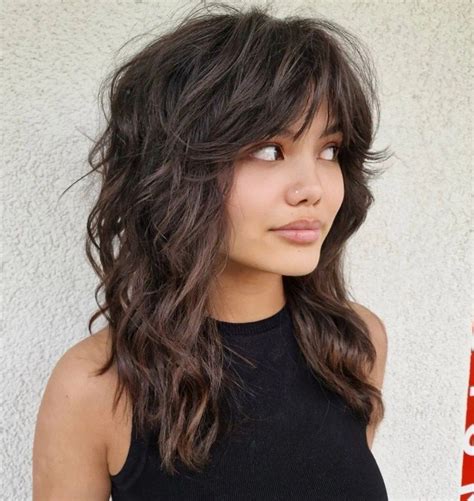What is a Wolf Cut?

The wolf cut, a captivating fusion of the iconic shag and mullet, has taken the hair world by storm. Popularized in the 1970s, it has recently resurfaced with a modern twist, blending choppy layers, feathered bangs, and a volume-enhancing silhouette.
Key Characteristics of a Wolf Cut:
- Choppy, layered top and sides
- Feathered bangs
- Voluminous crown
- Angular, edgy silhouette
Benefits of a Wolf Cut:
- Versatility: Suitable for various face shapes and hair textures
- Style Flexibility: Can be styled in multiple ways, from messy and textured to sleek and polished
- Texture and Volume: Layers create movement and volume, enhancing fine or flat hair
- Face-Framing: Bangs and layers strategically frame the face, highlighting features and minimizing flaws
Variations of the Wolf Cut
The wolf cut is a highly customizable hairstyle, offering countless variations to suit individual preferences.
1. Short Wolf Cut with Wispy Bangs: Ideal for those seeking an edgy and androgynous look.
2. Long Wolf Cut with Curtains Bangs: A more ethereal and romantic interpretation, featuring long layers and soft, curtain-like bangs.
3. Asymmetrical Wolf Cut: Adds an element of uniqueness and drama by incorporating asymmetrical layers.
4. Shaggy Wolf Cut: Captures the essence of the 1970s with choppy, textured layers and feathered bangs.
5. Edgy Wolf Cut with Spiky Layers: Embraces the wolf cut’s rebellious spirit with spiky, layered sections.
Face Shapes Best Suited for a Wolf Cut
While the wolf cut can complement various face shapes, it is particularly flattering on those with:
- Oval faces: Elongates the face and creates balance
- Round faces: Adds definition and angles
- Square faces: Softens angular features and creates a more delicate silhouette
Hair Textures Suitable for a Wolf Cut
The wolf cut works well with a wide range of hair textures, including:
- Straight hair: Enhances volume and movement
- Wavy hair: Defines waves and adds texture
- Curly hair: Can be cut to minimize frizz and create a structured shape
How to Style a Wolf Cut
- Apply Volumizing Products: Use mousse or root lifter to enhance volume at the crown.
- Dry with Diffuser: Utilize a diffuser to create natural waves and texture.
- Texture with Dry Shampoo: Spray dry shampoo on the roots and mid-lengths to add grit and definition.
- Straighten or Curl Bangs: Style bangs with a flat iron or curling iron to achieve the desired effect.
- Experiment with Partings: Change the parting to create different looks, such as a center part or side part.
Tips and Tricks for a Perfect Wolf Cut:
- Avoid Over-Layering: Excessive layering can compromise the integrity of the hair and create a frizzy appearance.
- Maintain Regular Trims: Regular trims prevent split ends and keep the layers fresh and defined.
- Use Heat Protectant Spray: Protect hair from heat damage when styling with hot tools.
- Consider Your Hair Type: Consult with a professional stylist to determine the optimal wolf cut variation for your hair texture.
- Experiment with Hair Accessories: Add flair to your wolf cut with headbands, scarves, or clips.
Common Mistakes to Avoid
- Going Too Short: Avoid cutting the hair too short initially as it may take time to grow out to the desired length.
- Over-Styling: Excessive styling can weigh down the hair and diminish its natural volume.
- Igniting a Center Part: A center part can create an unflattering inverted V-shape on the forehead.
- Not Embracing Texture: Wolf cuts thrive on texture, so don’t shy away from adding waves, curls, or piecey layers.
- Overdoing the Bangs: Bangs can be a defining feature of a wolf cut, but too much length or density can overwhelm the face.
Step-by-Step Approach to Cutting a Wolf Cut
- Section Hair: Divide hair into four sections: top, sides, back, and bangs.
- Cut Top Layers: Create short, choppy layers on the top of the head, keeping the length longer in the front.
- Taper Sides: Cut the sides at a shorter length than the top, gradually tapering them towards the back.
- Connect Sides to Back: Blend the side layers into the back to create a seamless transition.
- Cut Bangs: Section off and cut the bangs into your desired shape and length.
- Refine and Texturize: Use thinning shears or a razor to create texture and blend the layers.
- Style: Dry and style the wolf cut as desired.
Conclusion
The wolf cut is a versatile and edgier hairstyle that embraces volume, texture, and individuality. By understanding its key characteristics, variations, suitable face shapes, and styling techniques, you can achieve a wolf cut that complements your unique features and enhances your style. Whether you seek a bold and edgy look or a more ethereal and romantic interpretation, the wolf cut offers endless possibilities for self-expression and hair experimentation.
